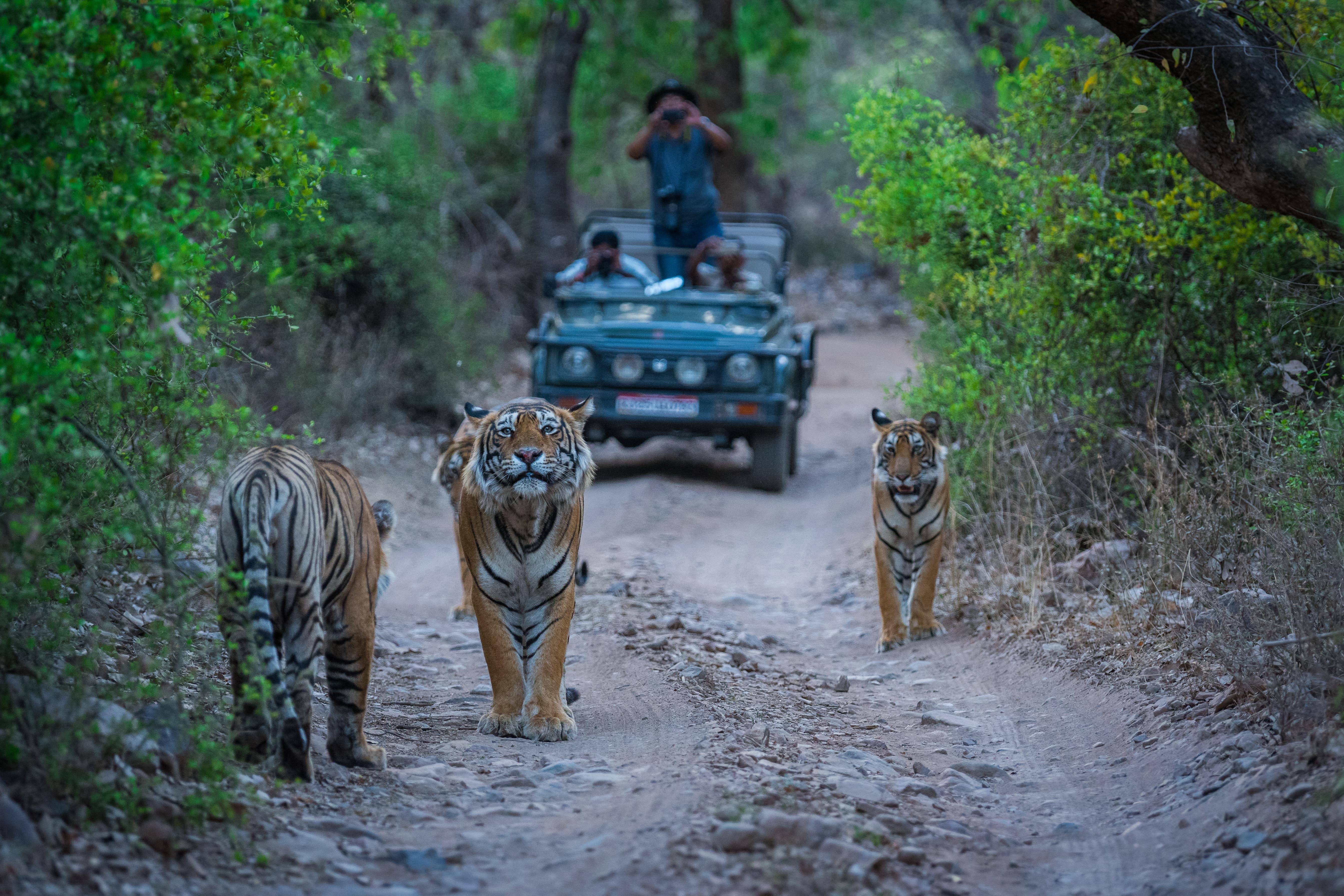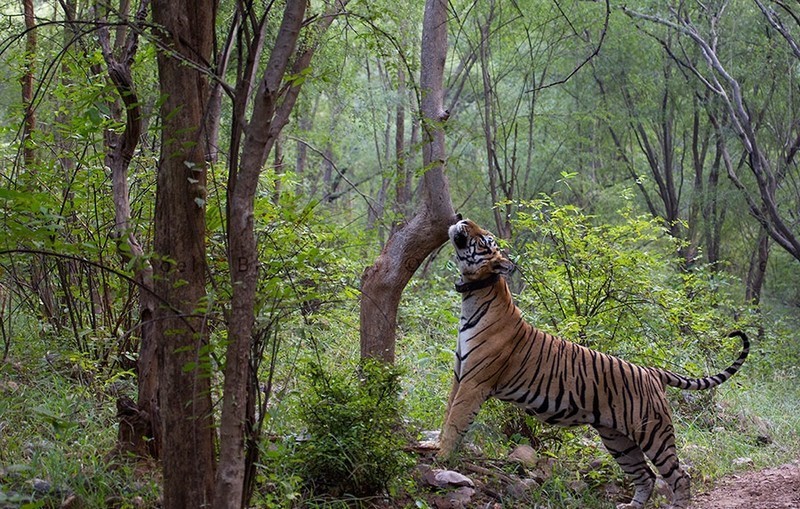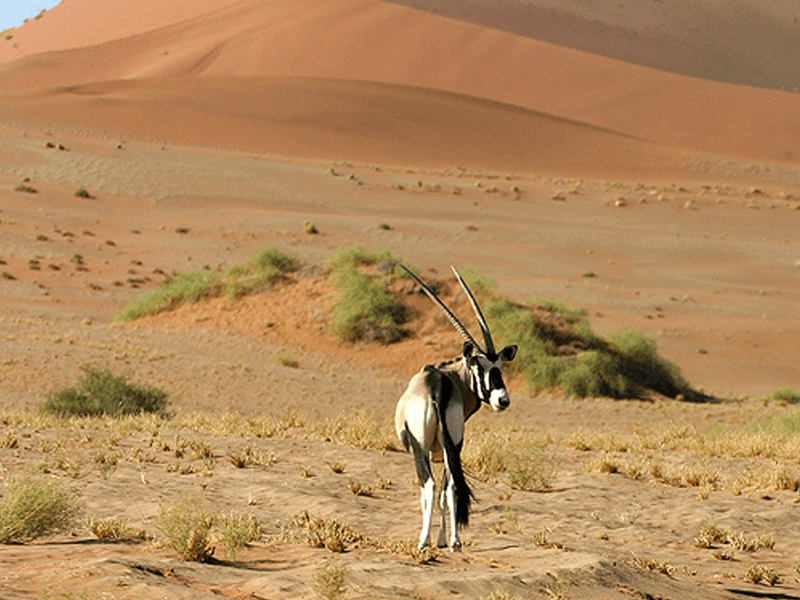Rajasthan, India's largest state by area, is renowned for its historical forts, palaces, and vibrant culture. However, beyond the grandeur of its cities lies a realm of breathtaking natural beauty and incredible wildlife. The state boasts a diverse range
of ecosystems, from arid deserts to lush forests, making it a prime destination for wildlife enthusiasts. In this extensive guide, we'll delve deep into the top 5 wildlife jungle safari destinations in Rajasthan,
you can cover this Rajasthan wildlife Tour Package each offering a unique glimpse into the fascinating
world of Indian wildlife.
1. Ranthambore National Park

Ranthambore National Park, located in the Sawai Madhopur district of Rajasthan, is undoubtedly one of the crown jewels of India's wildlife reserves. Spread over 1,334 square kilometers, this park is renowned for its thriving population of Bengal tigers,
making it one of the best places in the country to spot these majestic big cats.
The park's rugged terrain is dotted with picturesque lakes, ancient ruins, and dense forests, providing an enchanting backdrop for your safari adventures. The imposing Ranthambore Fort, which dates back to the 10th century, looms over the landscape and adds
a historical dimension to your wildlife encounters.
Apart from tigers, Ranthambore is home to a rich array of wildlife, including leopards, sloth bears, striped hyenas, and a variety of deer species. The park is also a haven for birdwatchers, with over 320 species of birds, making it an ideal destination
for ornithological enthusiasts.
To enhance your safari experience, Ranthambore offers various types of safaris, including jeep safaris and canter safaris, each providing a unique perspective on the park's flora and fauna. The best time to visit is from October to June, with the cooler
months of November to February being particularly favorable for wildlife sightings.
Suggested Tour:
Delhi Ranthambore 3 Days Tour
2. Sariska Tiger Reserve

Another gem in Rajasthan's wildlife crown is the Sariska Tiger Reserve, situated in the Alwar district. This reserve, covering an area of approximately 866 square kilometers, is known for its diverse range of wildlife, including the elusive Bengal tiger.
Apart from tigers, Sariska is home to a variety of species, including leopards, jungle cats, hyenas, and sambar deer. The landscape here is characterized by rugged hills, deep valleys, and dense forests, making it a haven for adventure seekers and wildlife
enthusiasts.
One of the unique features of Sariska is the Sariska Palace, which lies within the reserve and has been converted into a hotel. Staying here provides a truly immersive experience, as you can hear the sounds of the wild even from the comfort of your room.
Sariska is also steeped in history, with several ancient temples and forts within its boundaries. Combining wildlife exploration with cultural excursions makes this reserve a well-rounded destination for travelers.
To maximize your chances of wildlife sightings, it's advisable to visit Sariska during the winter months when animals are more active and visible. The park remains closed during the monsoon season, from July to September.
3. Keoladeo National Park (Bharatpur Bird Sanctuary)

Keoladeo National Park, also known as the Bharatpur Bird Sanctuary, is a UNESCO World Heritage site and one of the most renowned bird sanctuaries in the world. Located in the Bharatpur district of Rajasthan, this park covers an area of 29 square kilometers
and is a paradise for birdwatchers.
The park's main attraction is its vast wetland ecosystem, which hosts an astonishing variety of avian species, including both resident and migratory birds. During the winter months, Keoladeo becomes a temporary home to thousands of migratory waterfowl, including
the iconic Siberian crane.
Exploring the park is a delightful experience, whether you're on foot, cycling, or riding a cycle rickshaw. The easy accessibility and well-maintained trails make it suitable for visitors of all ages and fitness levels. The park's star attraction, the Ghana
Bird Sanctuary, is a man-made freshwater wetland that serves as a crucial breeding and feeding ground for numerous bird species.
Apart from birds, you may also spot other wildlife like sambar deer, nilgai, and wild boar. The best time to visit Keoladeo National Park is during the winter months, from October to March, when the weather is pleasant, and the bird activity is at its peak.
4. Desert National Park

Desert National Park, situated near the town of Jaisalmer, offers a dramatically different wildlife experience compared to the lush forests of Ranthambore and Sariska. This park is a testament to the unique desert ecosystem of Rajasthan, covering an area
of 3,162 square kilometers.
The landscape here is dominated by rolling sand dunes, thorny shrubs, and arid plains. Despite the harsh conditions, the park supports a surprising variety of desert-adapted wildlife. One of the flagship species of the park is the Great Indian Bustard, one
of the heaviest flying birds in the world. This critically endangered bird is a rare and remarkable sight for birdwatchers.
Other wildlife found in Desert National Park includes desert foxes, blackbucks, chinkara, and a host of reptiles like the spiny-tailed lizard and saw-scaled viper. The park is also a fantastic location for stargazing, as its remote location ensures minimal
light pollution.
To truly immerse yourself in the desert experience, consider a camel safari in addition to the traditional jeep safari. The best time to visit is during the cooler months, from November to March, when temperatures are more manageable, and wildlife is easier
to spot.
5. Mount Abu Wildlife Sanctuary

Mount Abu, the only hill station in Rajasthan, offers a refreshing change from the desert landscapes the state is known for. Nestled in the Aravalli Range, Mount Abu Wildlife Sanctuary is a hidden gem that provides a unique and diverse wildlife experience.
This sanctuary spans an area of 290 square kilometers and is home to a variety of flora and fauna. Wildlife enthusiasts can spot leopards, jungle cats, hyenas, Indian civets, and a rich assortment of bird species. The lush greenery and serene Nakki Lake
nearby add to the sanctuary's charm, making it a perfect destination for nature lovers and hikers.
One of the sanctuary's unique features is the presence of a high-altitude plateau, making it a cool and pleasant escape during Rajasthan's scorching summers. Treks and nature walks in the sanctuary offer a chance to explore the region's diverse ecosystems,
from dense forests to open grasslands.
The best time to visit Mount Abu Wildlife Sanctuary is from February to June and then from September to December, avoiding the monsoon season when heavy rainfall can disrupt travel plans.
Conclusion
Rajasthan's wildlife sanctuaries and national parks offer a diverse range of ecosystems and an incredible array of wildlife species, making them must-visit destinations for nature enthusiasts and wildlife photographers. From the iconic Bengal tigers of Ranthambore
to the avian wonders of Keoladeo National Park, each destination promises a unique and memorable experience.
When planning your wildlife safari in Rajasthan, be sure to consider the best time to visit each park, as wildlife activity and weather conditions can vary significantly throughout the year. Additionally, it's advisable to book your safari in advance to
secure your spot and make the most of your journey into the heart of Rajasthan's wild side. So, pack your binoculars, put on your safari hat, and get ready to embark on an unforgettable adventure through Rajasthan's wilderness.